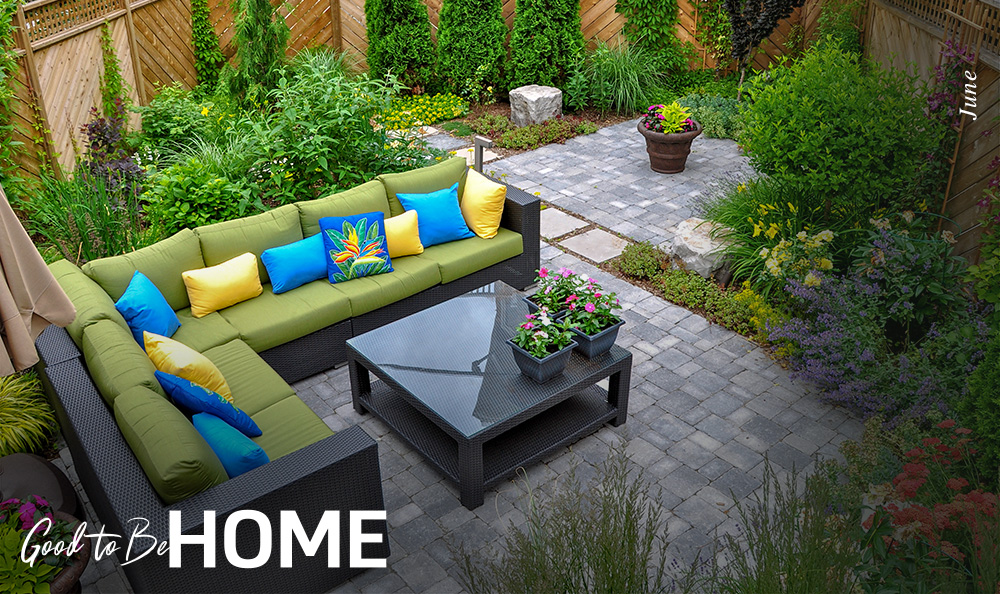The end of June marks the official start of the summer season, and there’s no better way to celebrate than by getting your home ready for the fun days ahead. This edition of Good to Be Home has tips to help you get your home’s indoor and outdoor spaces ready for the season, including hardscaping basics, a home relocation guide, and much more.
Your yard and garden both play big roles in the overall impact of your home’s curb appeal. But landscaping isn’t just about planting flowers and trees—it also means bringing in nonliving materials such as rocks and hardwood in a variety of ways. Inside you’ll find great hardscaping ideas to help you transform your outdoor spaces into little slices of paradise.
Invasive species, or non-native plants and animals that rapidly spread in their new environment, can pose many threats to the local ecosystem. But what makes them so dangerous? The enclosed article offers insight into these harmful species as well as strategies you can use to help curtail the spread of them in your area.
Moving is never easy. There are dozens of steps to the process along with many different factors to consider. If you’re prepping for a big move this summer, either across the country or down the street, be sure to check out the different steps in this issue that can help ensure you have a successful move.
Buying furniture for your home may seem like a daunting task due to ever-evolving design trends. However, you always have the option to transform old or secondhand items into unique-to-you pieces for your living spaces. Inside, Jina Lee, owner of a furniture-flipping company, offers tips to help you create beautiful furniture you’re sure to love for years to come.
Here’s hoping you have a joyful June! As always, it’s a pleasure to send you this magazine.
Picture an elegant backyard garden or a house with spectacular curb appeal. Your first thoughts may be of tall, shady trees and vivid flowers sprinkled around a bright-green lawn. But just as colorful home decor needs neutrals for balance, cohesive landscaping requires a healthy amount of visual contrast to make the plant life pop. Enter hardscaping—the nonliving, yet equally pleasing, elements of outdoor design.
Hardscaping isn’t particularly exotic by definition. In fact, you may already have several of these features throughout your property: driveways, sidewalks, patios, and just about anything else in your yard made of hardwood, stone, or concrete. More elaborate examples include retaining walls, stepping-stone pathways, and brick borders around flower gardens. If you’re looking for ways to spruce up your yard, consider investing in these elegant hardscapes to create a stylish yet practical design—and potentially earn an excellent return on your investment.
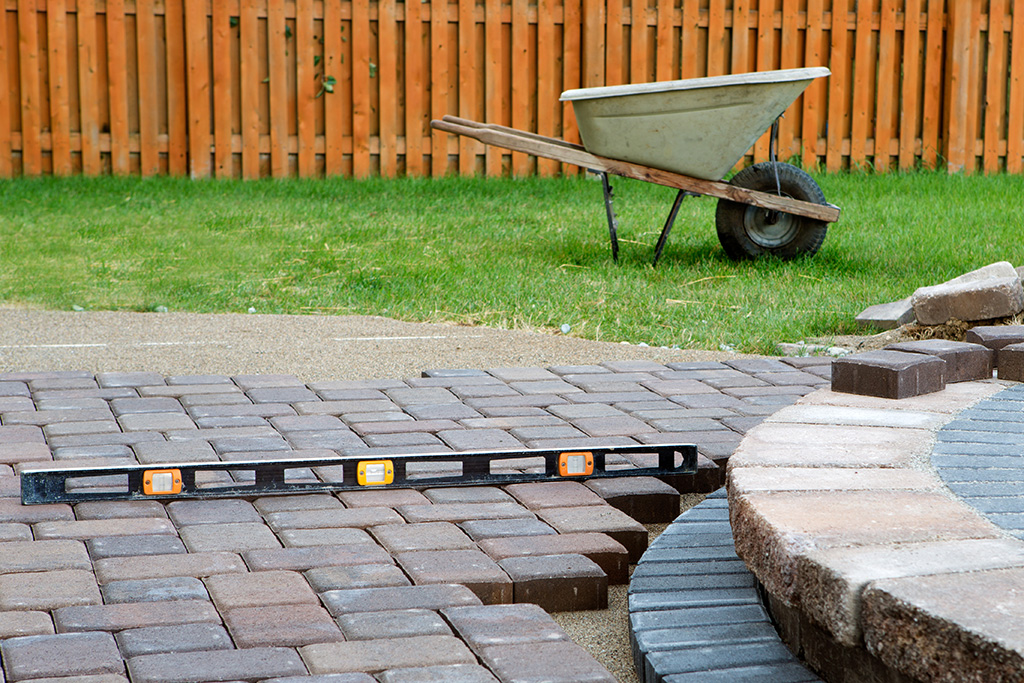
Keep in mind that good design always starts with function. Whenever you decorate any space, indoors or outdoors, you should ask yourself how you intend to use it. For example, a living room is typically used for relaxation and entertaining guests, which is why you likely filled yours with comfortable seating such as armchairs and sofas rather than a dining table or desk. Follow this same principle when deciding how to hardscape your yard. Would you like to use your outdoor spaces primarily for hosting parties, enjoying weeknight dinners with family, or taking leisurely strolls? With clear intentions at the center of your design, you can both choose appropriate features, such as a large pool deck, a patio, or a winding walkway, and feel confident in your decisions.
Before you make any changes, consider potential design limitations like a tight budget, homeowners association rules, or mature plants you would rather not uproot. These restraints may feel confining, but knowing them up front can help you formulate feasible ideas for your yard and avoid headaches down the road.
Once you’ve identified those factors, you can move on to the design. Because hardscape elements can vary widely in size, shape, material, color, and pattern, you might feel overwhelmed by your options. That’s why interior decorators will often choose a theme like “art-filled lounge” or “cozy family breakfast nook” to ensure their design feels cohesive. Using a singular theme can guide your choices and help you craft an outdoor design that works as a whole rather than as just a collection of assorted pieces.
So before you grab a shovel, determine what kind of look speaks to you. Do you envision your yard with a rustic and natural theme? Or do you prefer colorful bohemian, European estate, or contemporary and clean-lined aesthetics? If you’re short on inspiration, look to your interior design and think of how to carry the same elements outdoors but in weather-resistant materials.
For more ideas to kick-start your hardscape design overhaul, check out these creative concepts.
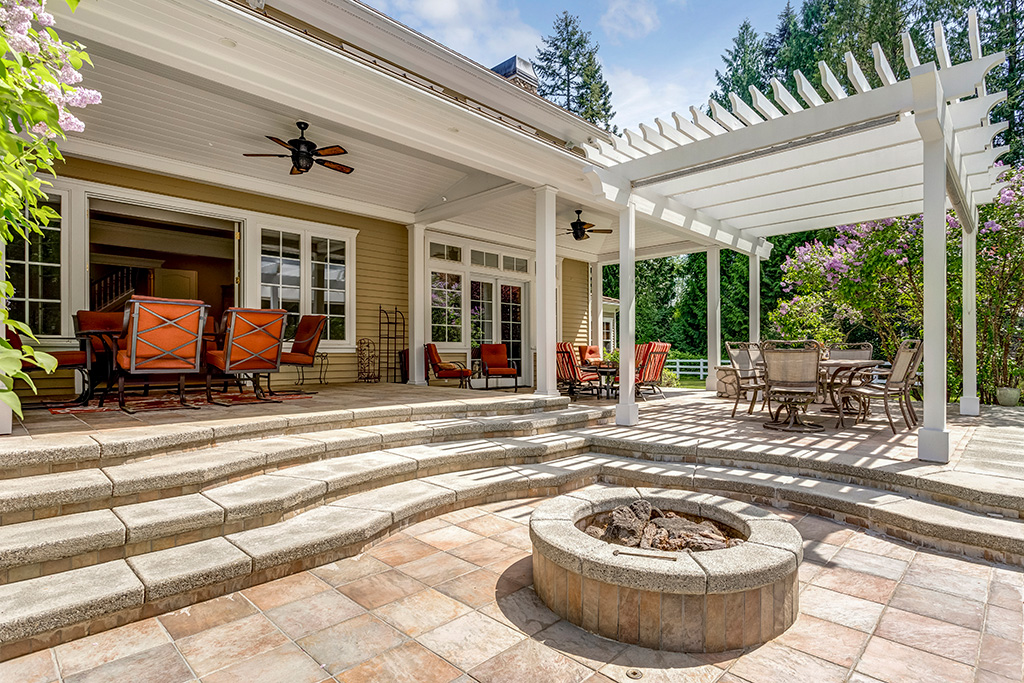
Sophisticated outdoor lounge
Design the perfect outdoor venue for a late-night cocktail hour. Lay stone pavers in a large circle amid mature greenery, install a firepit in the center, and then decorate the patio with comfortable lounge seating and cocktail tables. For the perfect party ambience, hang dramatic lighting like lanterns from the surrounding foliage.
Backyard kitchen
One of the most popular implementations of hardscapes, an outdoor kitchen can improve your hosting potential and make summer barbecuing a breeze. The options range from a finished concrete slab boasting a barbecue pit to a fully decked-out patio with appliances like a gas grill and sink. For best results, install flooring, cabinets, and countertops inspired by your indoor kitchen for a seamless indoor-outdoor design. Place a large table under a pergola, then put out enough chairs for friends and family.
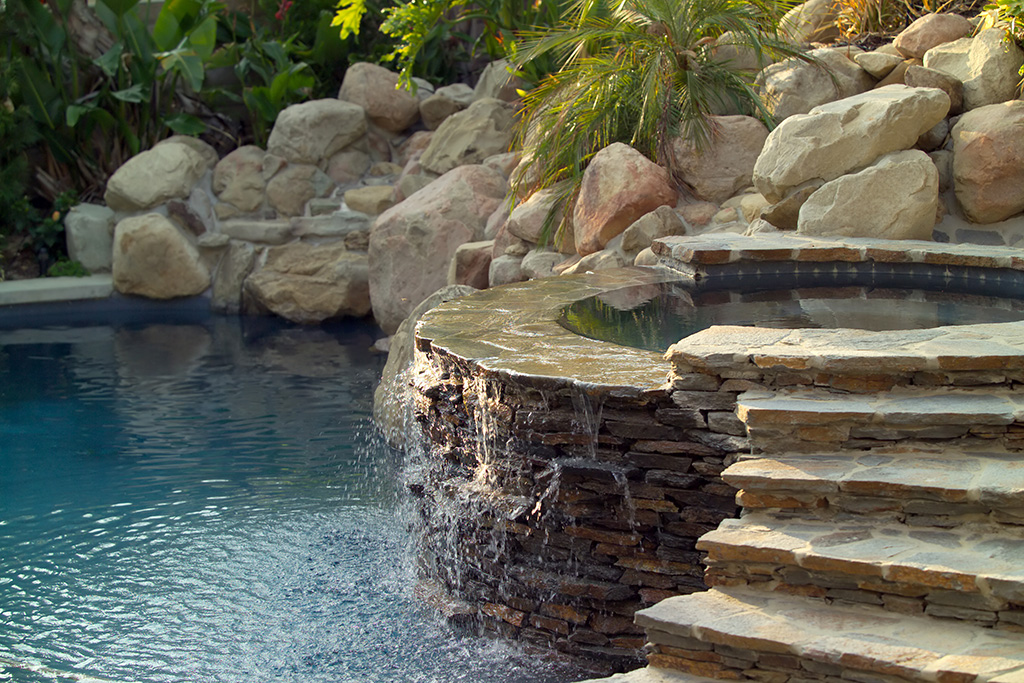
Natural pool scene
A swimming pool may be an enviable home feature, but hardscaping can make it distinctive. To elevate your pool, install features like a flagstone deck, a boulder rock wall, or irregular stone retaining walls around lush trees and shrubbery. Once completed, your backyard haven will resemble a natural pond or tropical resort pool.
Romantic garden promenade
Highlight your greenery with refined hardscapes. Line groupings of plants with neat bricks, place a few stone benches for relaxation, center the scene with a birdbath or grand fountain, and then surround the garden with a waist-height fence. For a palatial theme, build symmetrical hardscapes in light neutral colors. You can also replicate a similar design in your front yard for head-turning curb appeal.
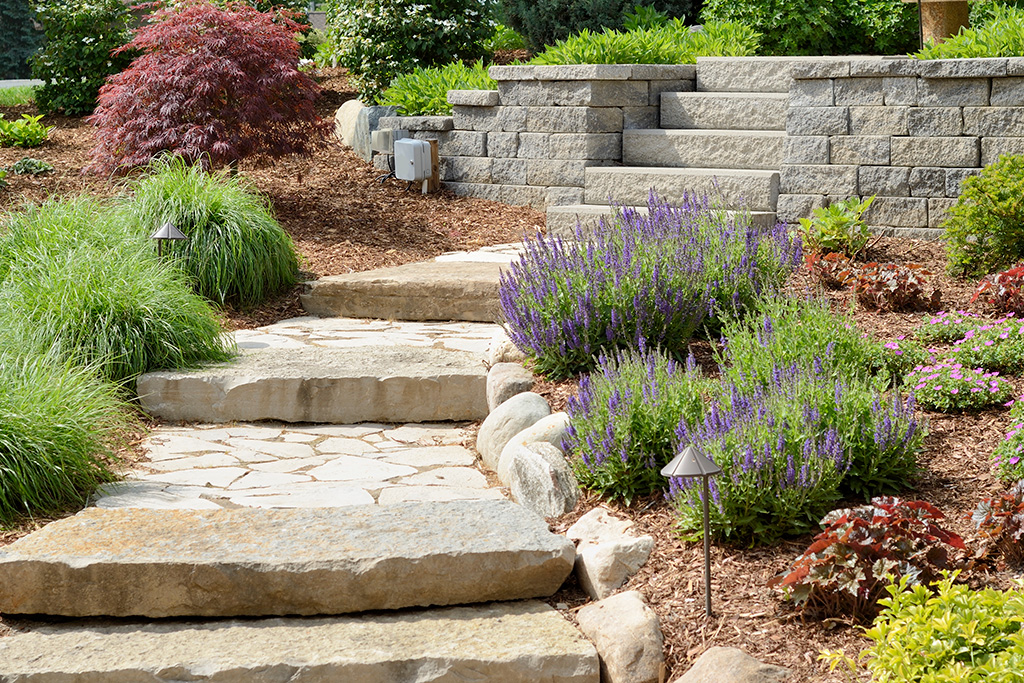
There’s no understating the design potential and return on investment that hardscapes can offer your yard. The possibilities are virtually endless: imagine the potential of gravel paths through hedges, stone stairs that descend gracefully down a rolling hill, or retaining walls that frame tall trees and invite you to take a seat under their branches. Once your yard transformation is complete, the beautiful balance of lively landscaping and practical hardscaping will make the space an impressive setting to take in the summer breeze.
Across the United States, goldfish are overrunning lakes and streams and threatening local ecosystems. Meanwhile, in western parts of the country, ornamental fountain grass, a decorative plant from Africa popularly used in landscaping, has been pushing out native grasses and ruining the natural habitat of frogs, toads, and other animals.
Invasive species can be found in nearly every ecosystem in the world, and human intervention is the cause of it all. Whenever we bring plants and animals from disparate places around the world to decorate our lawns and aquariums, these imports make their way into the local environment, sometimes with disastrous effects. Here’s how you can do your part to curb it.

A non-native species is considered invasive any time it spreads too well in its new environment and causes harm. And it’s not just nature that can be damaged by these aggressive visitors. Invasive insects, for example, can also eat crops, threatening food supplies, risking jobs, and negatively impacting the economy. Of course, not all exotic species fall under this category. Key American crops like tomatoes, wheat, and rice are all imports, but they don’t compromise local ecosystems the way invasive species do. Also, plants that would be invasive in some geographic locations might not be in others because of factors like climate or predators.
These dangerous guests can invade the United States in any number of ways. For instance, you may be able to find them being sold at local garden or pet stores; unfortunately, many consumers are unaware of their drawbacks. They can also hitchhike their way into the country via trade from other nations, which is how the tree-and-plant-gobbling spotted lanternfly is believed to have traveled here. Invasive species don’t always come from abroad, however. Even introducing a species from one state to another can create a problem, as it can then be spread even further via our shoes or clothing or by birds, bees, and other creatures.
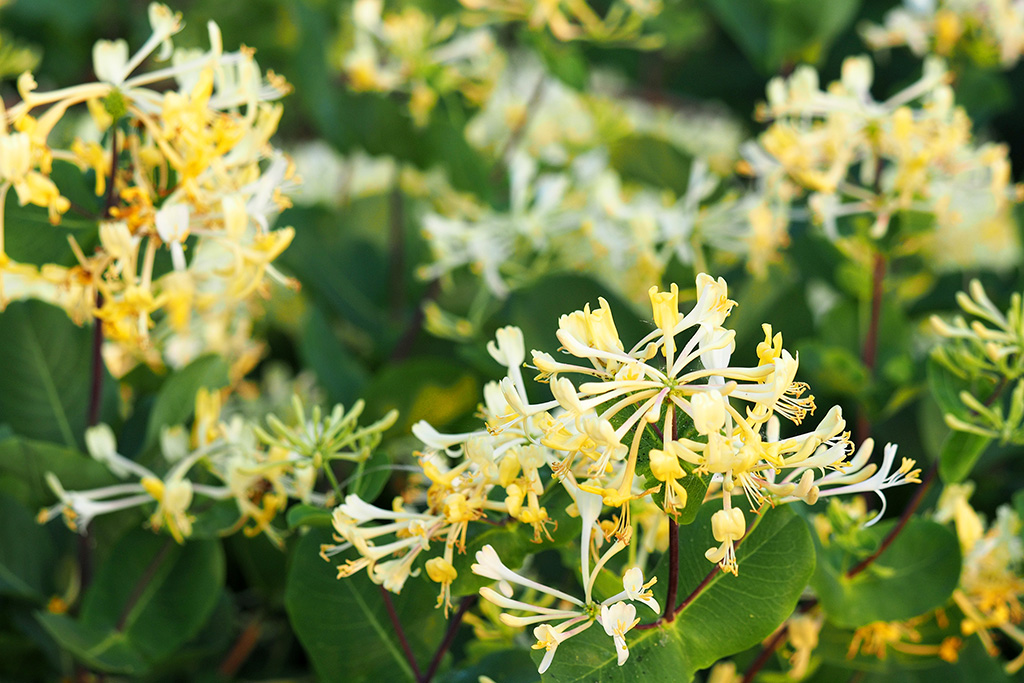
Thankfully, there are many ways you can help prevent the spread of invasive species. For starters, when selecting plants for your garden or yard, do your research or use an app like PlantNet to make sure that what you buy isn’t invasive to your area. Some of the most common ones that homeowners might unwittingly add to their yards include bamboo, the butterfly bush, English ivy, Japanese honeysuckle, and the Norway maple. All of these are beauties—but they can still be incredibly destructive outside of their native environments.
If you really like the look of a particular invasive plant, you could try planting a similar-looking one that’s native to your area instead. For instance, the Virginia creeper is an ivy found naturally throughout eastern and central North America that can be used as a ground cover just like English ivy. (As a bonus, its leaves turn a vibrant purple or red in fall.) Alternatively, if you have your eye on an exotic plant like bamboo, you could opt for a noninvasive variety, such as a clumping kind of bamboo that grows much more slowly than invasive varieties and won’t harm the local ecosystem.
The most effective solution, though, is to simply plant native plants since they are often best for feeding and sustaining local insects, bees, and birds. You can use the handy tool on the National Audubon Society’s website to look up what grows naturally in your area.
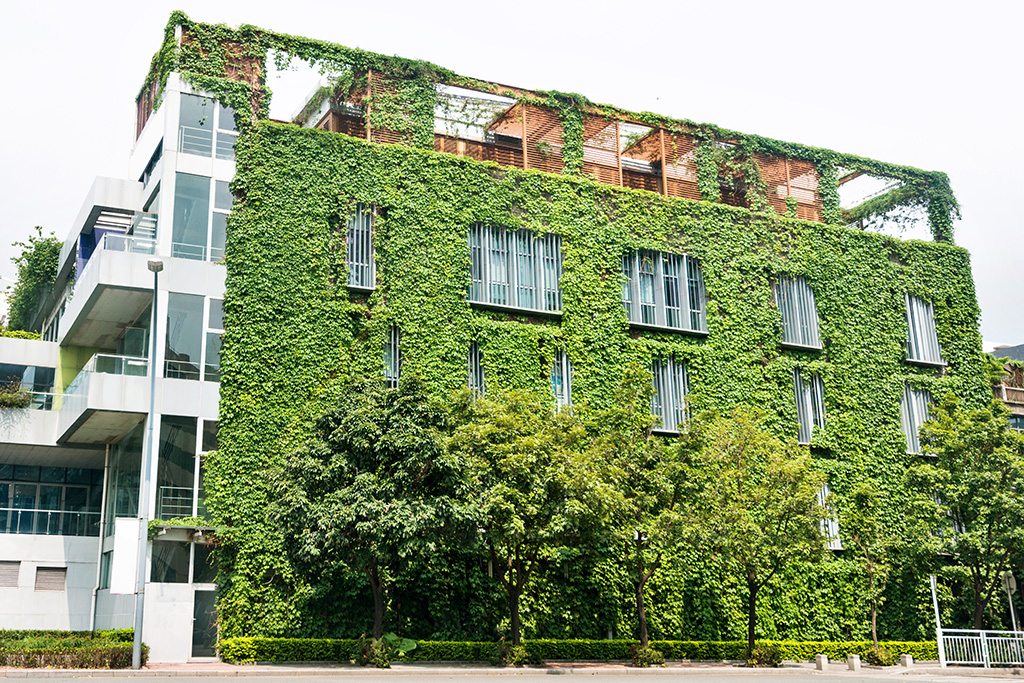
If you already have a plant, bush, or tree in your yard or garden that’s considered invasive for your locale, you can remove it by pulling it up or cutting it at the roots; just make sure to bag it carefully to prevent its seeds from spreading elsewhere. To get advice on how to handle specific invasive plants found in your yard, contact your local Master Gardener program.
When it comes to invasive animals, the most important action you can take is to properly care for your pets. The exotic pet trade is one of the primary causes of the spread of invasive species in our country; animals like exotic lizards, birds, and fish get into the environment when they escape their cages or enclosures or when their owners release them into the wild. These animals then become a threat to the biodiversity of local habitats, endangering native species. So if you own a pet that you can no longer keep, try to find a suitable home for them, such as by reaching out to any interested friends or family, taking them to an animal shelter or your vet, or returning them to the pet store.

In addition to making efforts at home to slow the spread of invasive species, you could donate your time to their identification and removal. For example, some state and national parks regularly host hikes that volunteers can join to locate and pull up harmful plants. If you can’t find a local removal effort, host one of your own instead.
Prevention is the best way to curtail the spread of invasive species, so it’s important to be vigilant. But even when dealing with non-native species that have already spread, it’s still possible to reduce their effect by working to boost awareness and reduce their prevalence.
Whether you’re staying local, crossing state lines, or moving to the other side of the country, relocating requires a good amount of planning, organization, and flexibility.
And it can get even more complicated depending on your reason for moving. For example, if your relocation is job related, your timeline may be tighter than if it’s for personal reasons. To ensure a successful move, implement these steps, which are perfect for any relocation plan.

You probably already know where you’re moving to, especially if you’re moving for a job. Now comes the hard part: picking your new home. Take some time now to prepare for your move and gather information about the communities you’re considering. You can learn a lot online about an area’s population and demographics, crime rates, health care, and job market, which would be especially helpful if you’re a two-income family and your partner needs to secure employment.
Establish your real estate needs
Often one of the most challenging tasks when relocating is selling your current home, so if that’s something you’ll need to do, consider seeking the services of a real estate agent, who can streamline and fast-track the process. They can also help connect you with an agent at your new location to assist you in finding a home or inquire about any available short-term rentals you can stay in until you decide where you want to put down roots.

Research neighborhoods
Don’t rush into purchasing a home if you’re unfamiliar with the community. If possible, visit your new digs and research the various neighborhoods before committing to a place to live. Sites like Livability and AreaVibes can help you get the lay of the land and gauge an area’s proximity to public transportation, shopping, and entertainment. You can also scout different areas to determine which school and place of worship meet your needs. You can even obtain walk and drive scores and access street and aerial views on Google Maps to see which neighborhood appeals most to you.
Calculate the cost of living
There will likely be a change in cost of living in your new location, so you should do some preliminary research to see how it will affect your monthly grocery budgets, taxes, and home prices. Consider consulting with a tax specialist or accountant, or use a cost-of-living calculator to obtain an estimate of what the cost differential will be.
Managing the logistics of moving from one location to the next requires careful organization, especially if you need to relocate immediately for a job or family emergency. To help you stay on top of everything, consider keeping a to-do list or calendar of all your important dates and tasks to complete. Start by marking your move date so you can create an accurate timeline of everything you need to do leading up to it, such as scheduling the mover, packing up your home, making travel arrangements, and preparing for arrival at your new location.

Moving is always expensive no matter how you slice it. Establishing a budget will help you manage the various costs associated with relocating and determine if you need to find cheaper alternatives. For instance, you may need to hire a professional moving company, but you can save money by packing yourself, purchasing packing supplies at a home store, or purging some of your belongings to lighten the truckload.
If you’re relocating for a job, you could also ask or negotiate with your company about what financial assistance they offer. Some companies will pay for all your moving and transportation costs, while others may only offer a stipend. Regardless of the package provided, obtaining this information up front can help you create a more realistic moving budget. Be sure to also consider travel costs such as food, fuel, tolls, lodging, and air travel.

There are many options for making the move itself, whether you hire help or decide to go it alone. Which method you choose will affect how you budget and execute your move.
Relocation companies
A relocation company, which is typically hired by employers for employees who are relocating, offers a broad range of services to facilitate your move from start to finish. This could include anything from securing a professional moving company and auto-transport company to assisting you in finding a place to live—short-term or long-term—with the help of a local real estate agent. It may even be able to point you toward the best schools for your kids and help your spouse find employment.
National or local professional movers
How far you’re moving will dictate the type of mover you hire. Most communities have local companies that will only drive certain distances, while a national mover will go over state lines and across the country. Either way, you should get at least two or three estimates and determine what will be included in the cost of the move, including any additional fees, insurance, and packing supplies.

Storage units
To give yourself time to settle in, consider renting a storage unit at your new location, especially if you haven’t found a permanent residence; your short-term living situation may not accommodate all your belongings.
Truck-rental companies
On the surface, moving on your own may seem relatively inexpensive and stress-free. However, when you factor in the hassle of renting a truck or trailer, as well as the time and physical strain it takes, that’s not always the case. So before choosing the DIY option, consider your fundamentals, including rental costs, fuel, insurance, the one-way drop-off charge (which can be expensive), and any hidden fees you may not be aware of. Inquire with the truck rental company about these factors so you can know how to budget accordingly.
Relocating to a new city or state can be a stressful event. However, by staying organized with a moving file, you can easily access your to-do list for both sides of the move and keep track of any estimates and receipts to help you stay on top of your budget.
Finding furniture for your home can be a challenge. With so many designs, styles, shapes, and colors to choose from, it’s not always easy to locate pieces that work perfectly with your decor and personal style. If you’ve been struggling in your search, it might be time to try upcycling—the sustainable practice of transforming old or secondhand furniture into unique pieces for your home.
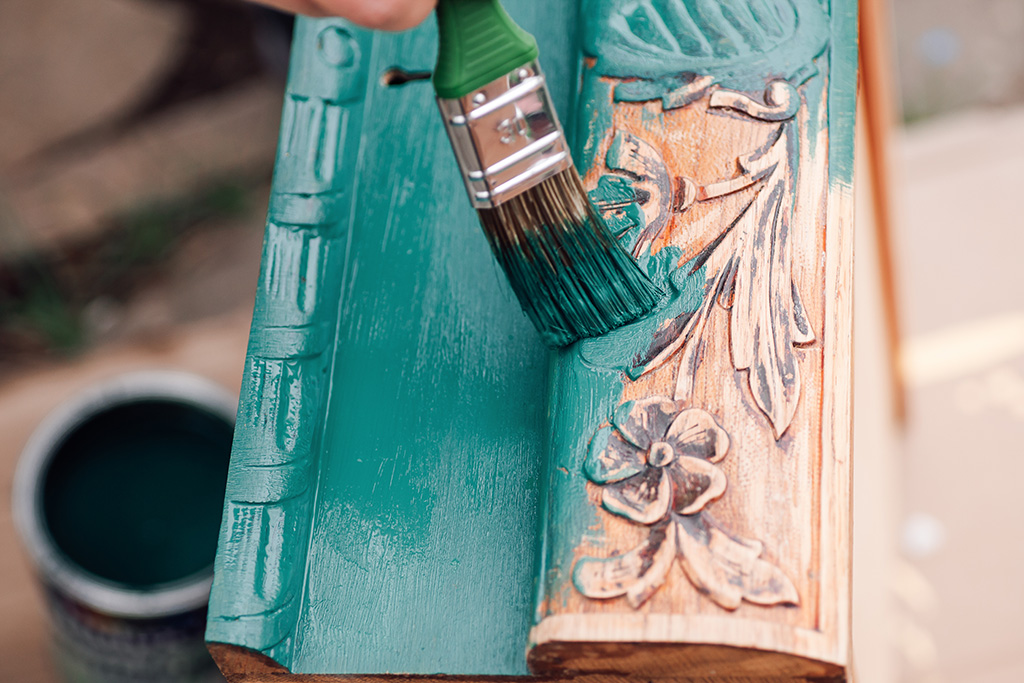
Jina Lee, owner of JLee Refinishings, first began upcycling furniture because of her frequent moves. “Between moving constantly due to my husband’s service in the United States Army and having young children, furniture inevitably became damaged,” she says. “The space, size, and vibe of our home also changed with each location, so I wanted to make my furniture fit.” She started by repairing and painting pieces she already owned, but she soon realized she had a knack for it and started taking commissions.
Today, Lee refinishes pieces her clients bring to her or ones she finds through Facebook Marketplace, on OfferUp, or in thrift stores. The upcycling process allows her to make outdated or worn-out furniture into one-of-a-kind pieces for both her and her clients. And it’s something you can do for your home too! Whether your canvas is a dresser that no longer fits your style or an antique desk you found at a thrift store, get creative and experiment with different paint colors, materials, and styles. To help you through the process, here are four essential steps you’ll want to follow.
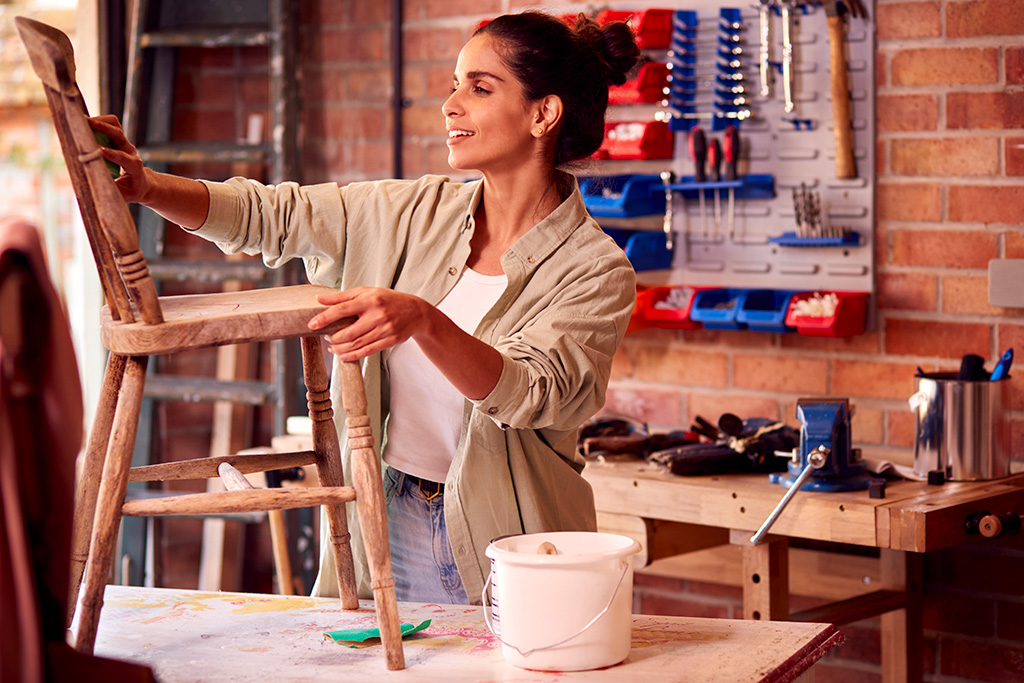
The first part of the process is deciding what you want to do with the piece. Are you looking to do a complete overhaul or simply repair scratches and change out old hardware? Does it need a wood stain that better matches your other furniture? Do you want to paint the whole piece or just the drawers? As you ponder your options, it’s important to consider not only what will work best for the piece but also what will fit with your living space. When flipping a piece for a client, Lee starts by asking them about their home, specifically what the overall aesthetic is of the room it will go in and what other furniture they have there. This helps Lee and her clients determine how they can make the upcycled furniture cohesive with everything else.
Once you have your overall vision, Lee says you can “look at inspirations and create mock-ups of the space.” She makes digital designs to help visualize the potential transformations, but you can search on Pinterest or Instagram for inspirational pictures, perusing what other people have done with similar items to get an idea of what you want.
During this part of the process, Lee will also decide which techniques and methods she wants to use on the piece. This could involve adding rattan to a door front, removing detailed framing, or using a new painting or staining method. There are a lot of ways to experiment with techniques that can achieve a fresh, exciting look. After all, you have the freedom to update the item as much as you want, changing it in whatever way makes it shine in your home.
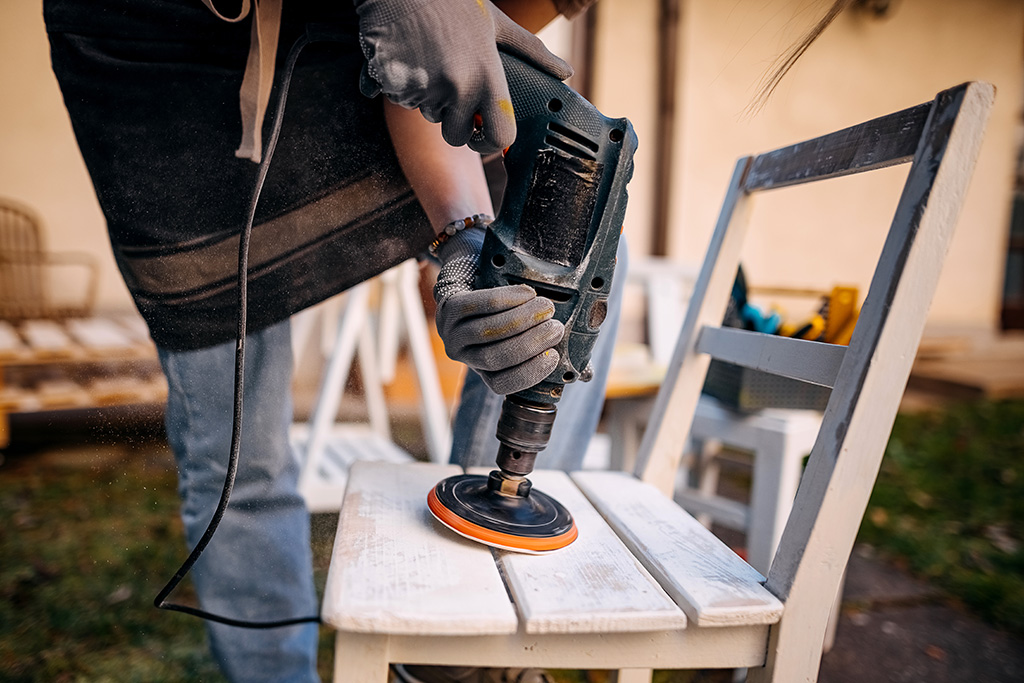
Many used or antique pieces will need repairs before you can upcycle them. While some will simply need a little wood filler to fix a crack, others may require more extensive restorations. “You can’t always find a replacement for a missing or broken item,” Lee shares. “Sometimes they were made using old standard dimensions, so fixing the issue may require ingenuity or a custom creation.” She adds that it’s a challenging process since “making a repair not look like a repair but rather a restoration takes significant commitment.” But it can also be incredibly rewarding in the end, as only you will know everything you had to do to get the piece in tip-top shape.
The required items for the flip will ultimately depend on what you’re doing to the piece. For example, you may need primer, paint, stain, brushes, or hardware for the upcycle. However, there’s one must-have item for most projects—sandpaper. “Almost every part of the process of refinishing a piece, from removing finishes to smoothing paint to repairing parts, will require sanding,” Lee says. But don’t fret if you don’t happen to own a power sander. Lee notes that you can ultimately accomplish the same thing with a basic hand sander; it just may take a little more time and elbow grease. Sanding will give you a smooth surface to work with, making it easier to paint, restain, or add detail to the piece.
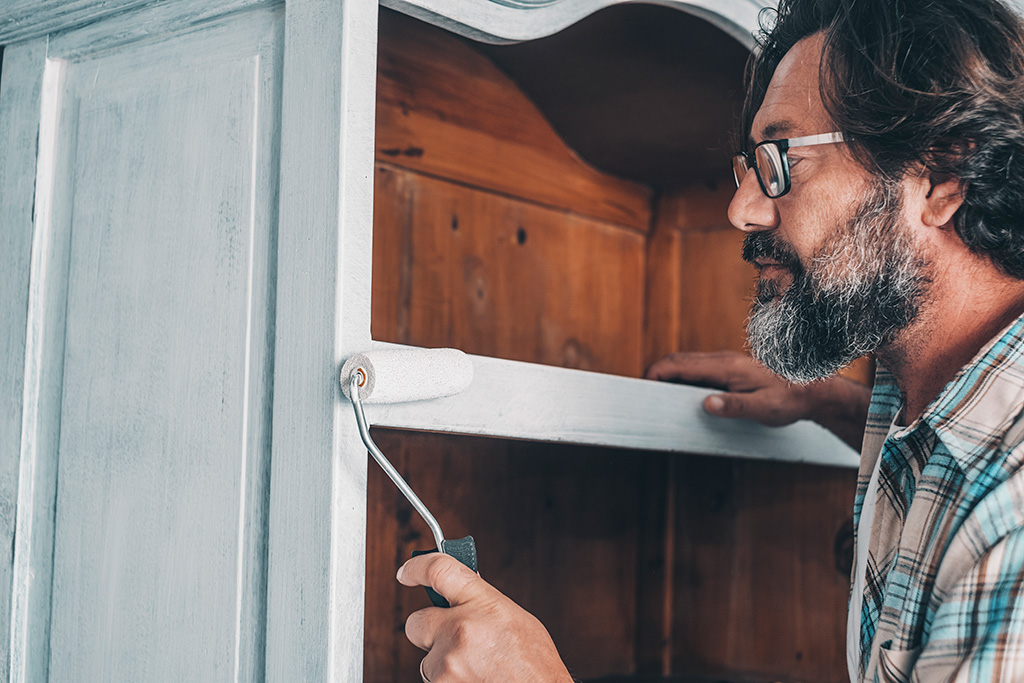
After you’ve gathered your supplies, sanded the item, and made necessary repairs, you’ll want to clean the entire surface to make sure it’s dust-free. Then you can get to work refinishing it according to your chosen design. If you’re painting any portion of the furniture, you should prime the surface first to better ensure that the paint adheres to the item. A pro tip is to lightly sand between layers of primer and paint to get rid of thicker brushstrokes and smooth the surface.
You may encounter unexpected issues during this process, such as paint looking streaky after it has dried or stain not adhering to the item. If this happens, Lee suggests reaching out to someone who has experience transforming furniture. “The furniture-flipping community as a whole is sharing and encouraging,” she says. “Don’t be scared to ask for help.” Consider joining a furniture-flipping or upcycling Facebook or Reddit group, where you can share your issue and ask for suggestions on what to do next.
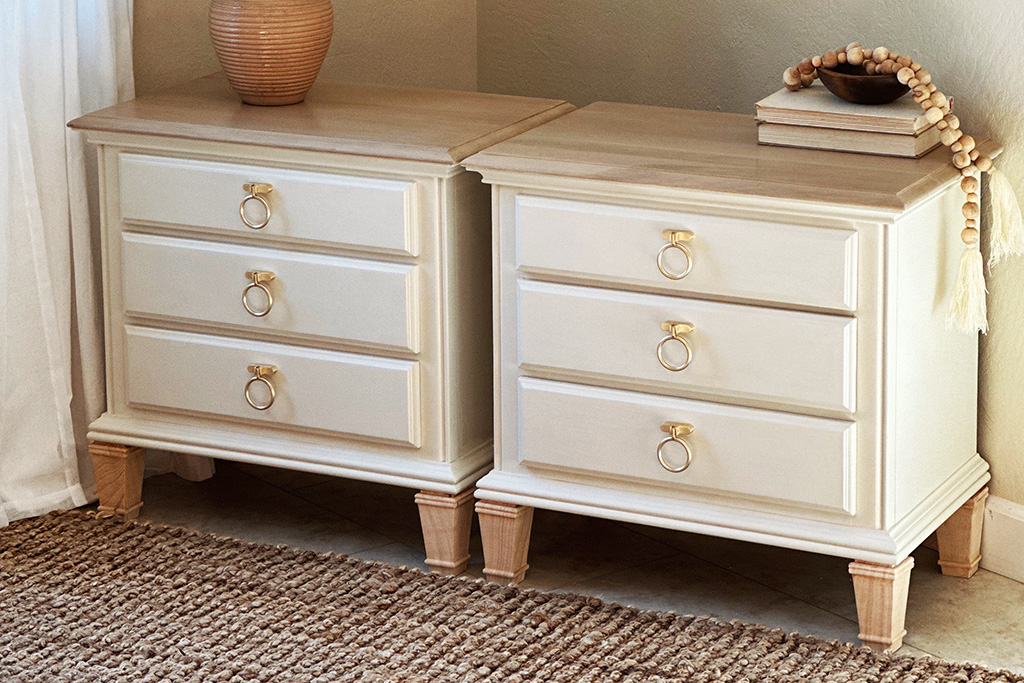
To complete the project, you’ll want to seal the piece with a top coat, such as a finishing wax, polyurethane, or polycrylic. Applied correctly, the top coat will create a hard surface that will prevent water stains, scratches, and other wear and tear from everyday use. In the end, you’ll have a beautiful, unique piece to keep in your home for years to come.
For more info, follow Jina on Instagram @jlee.refinishings
